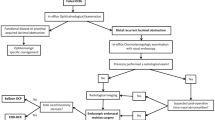Abstract
The objective of present study was to compare the results of endonasal endoscopic dacryocystorhinostomy and external dacryocystorhinostomy. It was a prospective non-randomized study. Forty consecutive patients having complaints of watering with complete naso lacrimal duct obstruction were selected for the study. Dacryocystography was done in all the cases. Selection of type of operation was left to the patient’s choice. All patients had preoperative counseling and both the procedures were explained in detail with their advantages and disadvantages. Twenty patients underwent endonasal dacryocystorhinostomy and twenty had external dacryocystorhinostomy. Silicon intubation was done in all cases of endonasal dacryocystorhinostomy for three months after surgery. The final follow-up was done at 12 months after surgery. The patency of lacrimal passage was confirmed by syringing and patients were questioned about their symptoms. There was no significant difference in the results of both surgeries. The complication rate in both groups was almost equal. Thus we came to the conclusion that these two different dacryocystorhinostomy techniques are acceptable alternatives.
Similar content being viewed by others
References
Toti A (1904) Nuovo metodo conservatore di cura delle suppurazoni croniche del sacco lacrimale (Dacrioustornostoma). Clin. Mod. Firenze 10:385–387.
Caldwell GW (1893) Two new operations for obstruction of the Nasal duct. New York Medical Journal 57:581–582.
West JM (1910) A window resection of nasal duct in cases of stenosis. Transactions of the American Ophthalmological Society 12(Pt. 2): 654–658.
Tarbet KJ, Custer PL (1995) External Dacryocystorhinostomy: Surgical success, patient satisfaction and economic cost. Ophthalmology 102(7):1065–1070.
Eloy. P, B Bertrand, M Martinoz, M Hoebeke M, Watelet. JB, Jamart (1995) Endonasal DCR Indications, techniques and results. Rhinology Dec. 33(4) 229–233.
Nalgirkar AR, Sulache AA. (2005) Comparative evaluation of results of endoscopic DCR and external DCR, Indian journal of otolaryngology and Head & neck Surgery II 363–365.
Hartikainen J, Antila J, Vaipula M, Puukaa P, Seppa H, Grenman R (1998) Prospective randomized comparison of endonasal endoscopic dacryocystorhinostomy Laryngoscope, December 108(12):1861–1866.
Mc Donogh and Meiring JH. (1989) Endoscopic transaction DCR. J. Laryngol otol 103(6); 585–587.
Author information
Authors and Affiliations
Corresponding author
Rights and permissions
About this article
Cite this article
Saroj, G., Rashmi, G. Conventional dacryocystorhinostomy versus endonasal dacryocystorhinostomy-a comparative study. Indian J Otolaryngol Head Neck Surg 62, 296–298 (2010). https://doi.org/10.1007/s12070-010-0087-4
Published:
Issue Date:
DOI: https://doi.org/10.1007/s12070-010-0087-4




